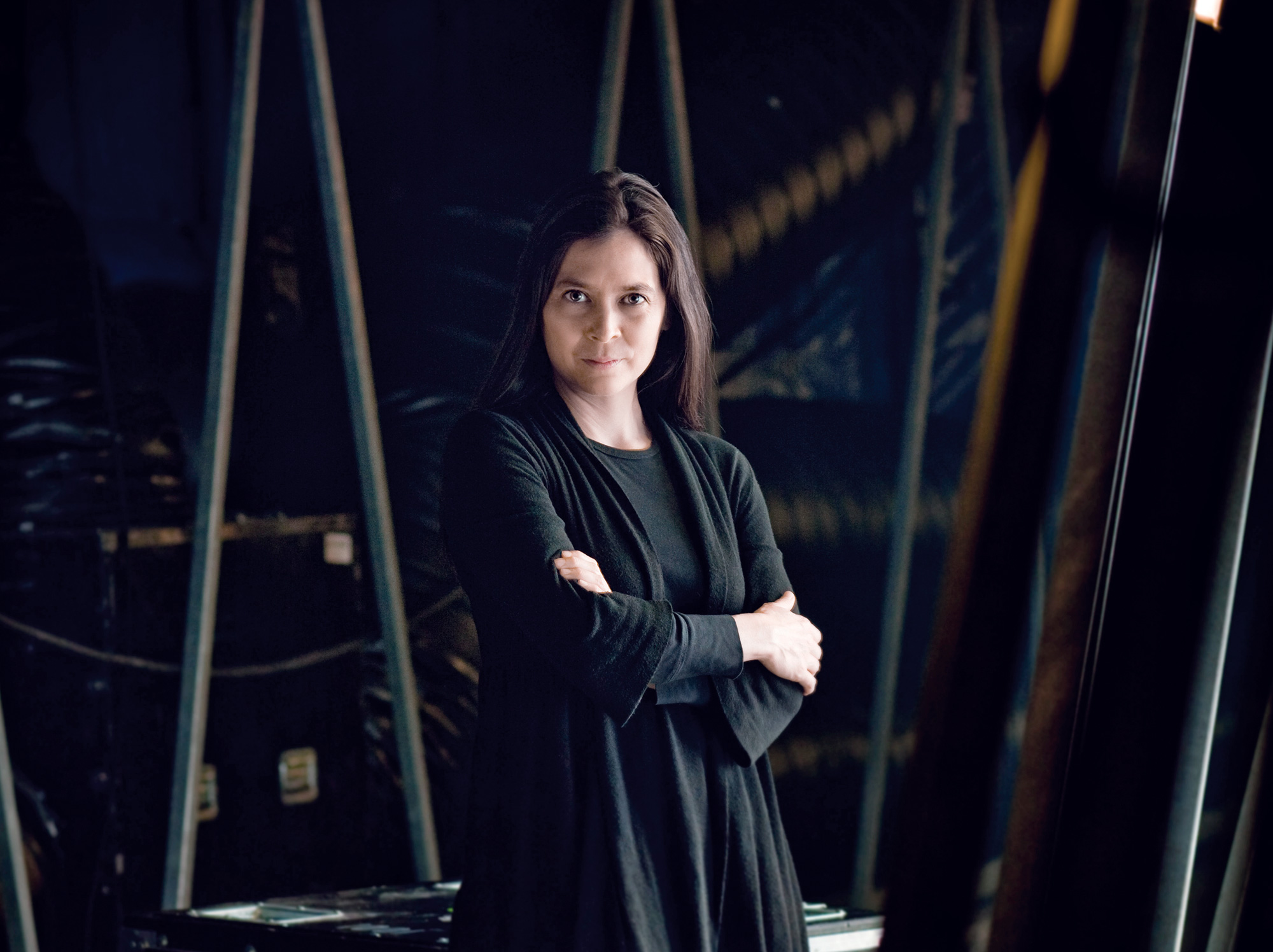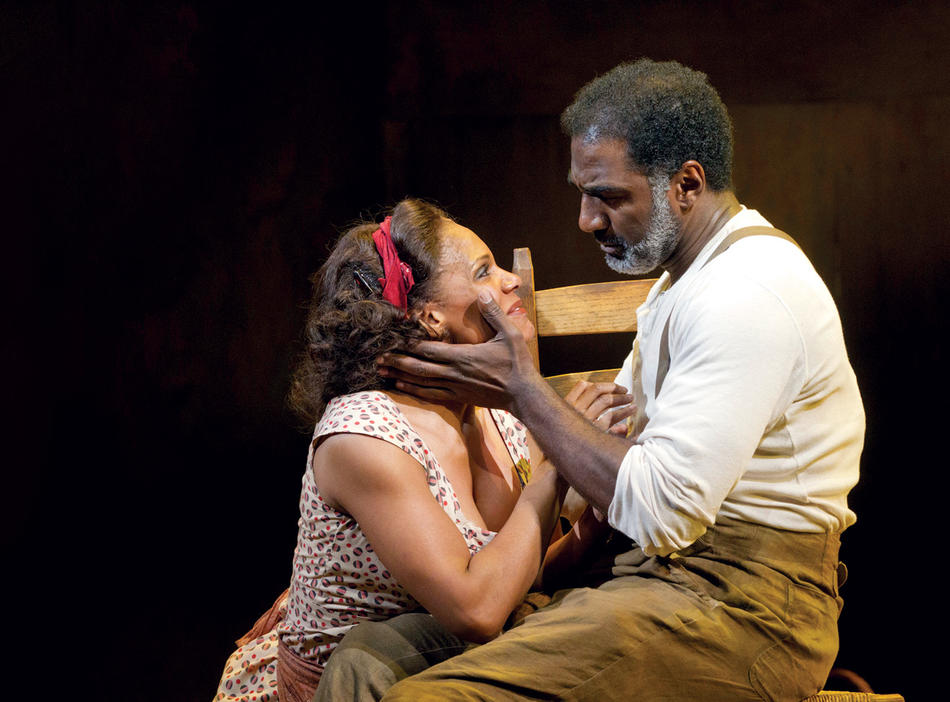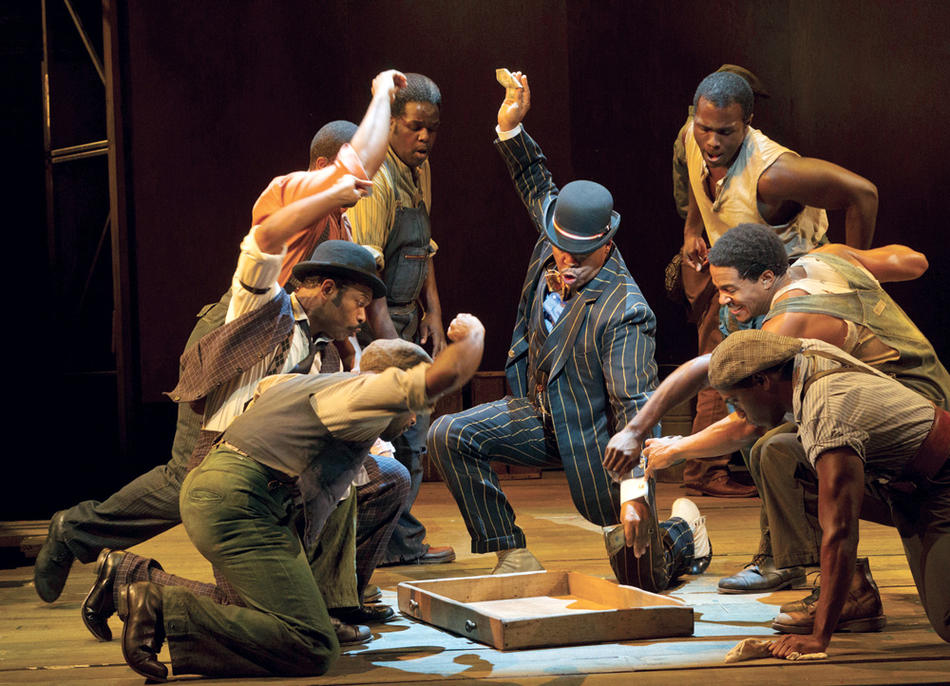
“Be bold.” This was what the estates of George and Ira Gershwin and DuBose and Dorothy Heyward advised director Diane Paulus ’97SOA as she took on a towering creative task: transforming one of the benchmarks of American music, the 1935 opera Porgy and Bess, into a Broadway musical attuned to present-day sensibilities.
The admonition was probably superfluous. This was, after all, an artist who had staged an all-female version of A Midsummer Night’s Dream in a nightclub, with cross-dressing and disco songs. Her daring paid off: the 1999 off-Broadway production of The Donkey Show ran for six years and toured internationally. As the artistic director of the American Repertory Theater (ART) in Cambridge, Massachusetts, since 2008, Paulus has built on the experimental tradition of one of the country’s most prestigious regional theaters. And her fortieth-anniversary revival of Hair, which concluded with the audience dancing onstage, received rapturous reviews and a Tony Award.
But The Gershwins’ Porgy and Bess — the production’s official title — represented a more daunting challenge: adapting the opera would mean figuring out how to approach African- American characters written by white men in the 1920s and ’30s. To wrestle with that question, Paulus brought in some heavyweights: Obie Award–winning composer Diedre L. Murray, Pulitzer Prize–winning playwright Suzan-Lori Parks, and four-time Tony Award–winning actress Audra McDonald, who quit the television series Private Practice to play Bess.
Last summer, during rehearsals for Porgy and Bess at the ART, which is resident at Harvard, Paulus shared her thoughts about this undertaking with New York Times theater reporter Patrick Healy. “In the opera, you don’t really get to know many of the characters as people, especially and most problematically Bess,” Paulus told Healy. “I’m sorry, but to ask an audience these days to invest three hours in a show requires having your heroine be an understandable and fully rounded character.”
These remarks, echoed by Parks and McDonald, might not have seemed particularly outré in an age of sometimes-radical revivals. Consider, for example, the surgery recently performed on one decidedly lesser work, On a Clear Day You Can See Forever, in which the female lead morphed into a gay man. But when Healy’s article was published in the Times on August 7, one reader in particular was appalled. Stephen Sondheim, perhaps the greatest living figure in musical theater and a great admirer of Porgy and Bess, fired off a blistering letter to the editor.
“Ms. Paulus says that in the opera you don’t get to know the characters as people,” Sondheim wrote. “Putting it kindly, that’s willful ignorance. These characters are as vivid as any ever created for the musical theater, as has been proved over and over in productions that may have cut some dialogue and musical passages but didn’t rewrite and distort them.”
“If she doesn’t understand Bess and feels she has to ‘excavate’ the show,” he wrote, “she clearly thinks it’s a ruin, so why is she doing it? I’m sorry, but could the problem be her lack of understanding, not Heyward’s?”
Hundreds of Times readers responded, most as outraged as Sondheim. Paulus’s Porgy and Bess, scheduled to open in Cambridge in just days, was spectacularly savaged, its Broadway future thrown into doubt — all before the curtain had risen on a single performance.
“What’s important to know,” says Paulus, forty-five, a diminutive woman with piercing eyes, long dark hair, and a forthright manner, “is that the Gershwin estate said, ‘We have the opera, and the opera is going to exist forever. We’re not asking you to do the opera. We’re actually coming to you to create a version of the show that will coexist with the opera, a version that will be for the musical-theater stage, for Broadway, which means for a broader audience.’ That was something that the estate was very passionate about. That was our charge.”
Based on a best-selling 1925 novel by the Charleston, South Carolina, writer DuBose Heyward and a stage adaptation by his wife, Dorothy, Porgy and Bess is the story of a crippled beggar and his lover, who live in a fictional black slum called Catfish Row. Even those who don’t know the opera are familiar with parts of the George Gershwin score: “Summertime,” “Bess, You Is My Woman Now,” and “It Ain’t Necessarily So.” Heyward, a poet as well as a novelist, wrote the libretto and collaborated with Gershwin’s brother, Ira, on the lyrics.
The early reaction to the opera, and its mostly black cast, was respectful, but critics didn’t always know what to make of it. Over the years, the work has toggled between the opera house and the musical-theater stage. It has also been subject to considerable tinkering. George Gershwin himself made about forty minutes of cuts to the four-hour piece between its Boston tryout and Broadway opening, and Cheryl Crawford, in her immensely popular 1942 version, which replaced recitatives with dialogue, streamlined it even more.
In 1952, a production initially starring William Warfield and Leontyne Price toured Europe to great acclaim. But Otto Preminger’s 1959 attempt to translate the opera to the screen, with a cast that included Sidney Poitier, Dorothy Dandridge, and Sammy Davis Jr., was not successful. A 1976 Houston Grand Opera production reestablished the piece’s operatic bona fides, and the Metropolitan Opera finally undertook its first Porgy and Bess in 1985.
Michael Strunsky ’62GS, the sole trustee of the Ira Gershwin Estate (and Gershwin’s nephew by marriage), says he has wanted a Broadway version of Porgy and Bess since he saw Trevor Nunn’s 1992 Covent Garden staging. Nunn’s 2006 Savoy Theatre production, intended for Broadway, never made it there. Strunsky calls that production “opera lite” and says he thought a more ambitious approach was needed.
In the spring of 2010, the Gershwin and Heyward trustees and their lawyers flew to Boston to meet with producer Jeffrey Richards, Paulus, and staff members in Paulus’s ART office. Suzan-Lori Parks attended via speakerphone.
“It was a pitch meeting,” Paulus says. “Suzan-Lori and I both talked about how much we loved the piece, and how evocative and stirring it is, not only as great music but great theater.” Their aim, they said, “would be to look at the arc of all the characters in the show and really strengthen that ... so that the audience feels engaged and involved with both Porgy and Bess from the moment they step on stage till the minute they leave.”
They discussed turning some of the recitatives into dialogue and modifying the show’s dialect: “It’s written in a form of Gullah that Suzan-Lori felt very strongly is not necessarily authentic because it’s DuBose Heyward’s impression of Gullah,” she says, referring to the Creole spoken by some groups of blacks in South Carolina and Georgia. Instead, she and Parks wanted the dialect to emerge from working with actors.
“One of the things that was very clear was that we wanted to keep the show, with intermission, somewhere between 2:30 and 2:35. That was necessary for Broadway audiences,” Strunsky says. The changes eventually encompassed the libretto, the staging, the voicing, and the orchestration, revamped for the much smaller show orchestra. Whole numbers were dropped; some solos turned into duets and quartets. The crippled Porgy, instead of being confined to a goat cart, would have a brace and cane. A scene in which a shady white lawyer sells Bess a fake divorce from her husband, Crown, would be given to Mariah, the matriarch of Catfish Row.
Overall, Parks says, Catfish Row characters were endowed with more agency. With a few introductory words of dialogue, Porgy’s “I Got Plenty of Nothing” was transformed, she says, from an offensive “happy-darky song” to a love song, with “nothing” now referring to “sexual relations and love.” When Bess follows the drug dealer Sportin’ Life to New York, she now does so for more complex reasons than mere addiction and weakness, including her own complicity in Crown’s murder. And the ending — though not as radically reimagined as Paulus and Parks first envisioned — features a more dignified Porgy setting off to find his Bess.
“I always had an instinct for making shows,” says Paulus.
The daughter of an actor–turned–television producer and an interior decorator, Paulus was raised four blocks from Lincoln Center. As a child, she studied dance with Mikhail Baryshnikov and was a serious pianist, but the loneliness of long practice sessions deterred her from a concert career. Meanwhile, she directed plays in her family’s living room, which led to a high-school production of Wonderful Town, where she met her future husband and collaborator Randy Weiner. (They now have two daughters, and commute between homes in Manhattan and Cambridge. Weiner runs both a Lower East Side nightclub called the Box and the ART’s second stage.)
Paulus attended Harvard, graduating in 1988, and enrolled in the New Actors Workshop in New York to study with director Mike Nichols and Paul Sills, a cofounder of Chicago’s improvisational comedy troupe Second City. But the life of a novice actor, with its uncertainty and constant waiting, quickly lost its appeal: “I had this entrepreneurial spirit. I was always interested in organizing people.” Plus, Paulus says, “I could fuel more of myself as a director.”
Paulus called some friends and started producing her own shows. For one production, she wangled permission to stage Shakespeare’s Twelfth Night in an Upper West Side community garden — on the condition that she could not stop anyone from gardening. No problem, Paulus figured: “If I could get someone to put the shovel down and listen to the play, we’d be doing something right.”
But it was hard to keep a fledgling company together in New York. With Sills’s help, Paulus, Weiner, and some colleagues relocated to Door County, Wisconsin. The shows made by their Blue Circle Theatre (later Project 400) were avant-garde and site-specific c. The company’s version of The Tempest featured a local bar band. Weiner puts it this way: “One of Diane’s strengths is her complete commitment to theater. One of my strengths is a questioning of theater.”
For Paulus, it was a superb apprenticeship: “It gave me an opportunity to experiment. I did everything. I was fundraising; I was acting in shows. I started with A Midsummer Night’s Dream and ended with Ode to Joy,” a play about Beethoven that featured twenty-five child actors. “We staged it in Lake Michigan — literally, in the water.”
But after five years, Paulus began to yearn for more training as a director. “I thought, ‘I need more tools; I need more stimulus. I want to go back to school.’”
At Columbia’s School of the Arts, Paulus studied under Andrei Serban, the director of the University’s Oscar Hammerstein II Center for Theatre Studies, and Anne Bogart, a professor of directing and artistic director of the SITI ensemble theater company.
“I carry Anne and Andrei with me every day,” Paulus says. “Anne is one of the most generous, open-hearted artists on the planet, and as a teacher, she was like an earth mother, nurturing each of us to pursue our interests. On the other side, you had Andrei Serban, a Romanian director who comes from that tradition of ‘You’re never good enough. You’re banal. Everything you do is not good.’
“Certain students collapse under that,” Paulus says. But having been a child ballerina trained by demanding Russian teachers, “I kind of thrived on it. To be told you’re not good enough is amazing training.”
Serban says that, as a graduate student, Paulus was “impeccable . . . well-behaved, disciplined but also inspired.” Citing her thesis production of King Lear, he notes: “Her best work then was as it is now: a unique marriage between traditional material and the avant-garde.”
Paulus “was already a remarkable force” when she entered the directing program, Bogart says. At Columbia, “she was continually innovating, not only with the plays and projects that she realized,” but by making “strong alliances with students and faculty,” many of whom would become colleagues.
While still a student, Paulus assisted Serban on a Massenet opera in Paris, where she met the impresario Brian Dickie. Dickie would later call on her to direct Monteverdi’s Orfeo at the Chicago Opera Theater. It was Paulus’s first opera.
Before graduating, Paulus sought advice from Bogart on what to do next. “She just looked at me, and she touched my heart. It was a physical gesture, like ‘Follow your heart.’”
In 2007, the phone rang, and the Public Theater was on the line. Would Paulus like to direct a fortieth-anniversary concert version of the rock musical Hair?
“I almost dropped the telephone,” she says. “Are you kidding? I know every song of that show, backwards, forwards.”
James Rado, one of the original creators of Hair, was impressed by both Paulus’s precision and her preparation during their collaboration on script changes. “I was elated by the working process,” Rado says. “She was aware of the original production; she’d studied the history. She did not want to repeat any of the ideas. She wanted to make it her own.”
The concert morphed into a fully staged production in Central Park in the summer of 2008 and was transferred to Broadway the following year. The revival featured powerhouse singing, exuberant interaction with audiences, and a sense of both the energy and pathos of America’s 1960s youth culture. The Times critic Ben Brantley called it “thrilling” and “emotionally rich.”
The tweaks Paulus and Rado made, including giving more voice to the female characters, were subtle rather than startling. “I made the decision early on that we’re not going to update Hair and make it about Iraq and Afghanistan,” she says. “We’re going to go back to 1967 and really look at what America felt like to a young person.”
The obvious antiwar parallels nevertheless contributed to the show’s resonance, making it simultaneously a historical snapshot and a more general lament against violence and cultural repression. Paulus’s work deepened Hair’s emotional connections by treating its characters “as living people, with all their flaws and virtues” and would become a prototype for Porgy and Bess.
Following Hair’s triumphal Broadway opening, the producer Jeffrey Richards visited Paulus in her dressing room. “Diane, I don’t give opening-night presents,” he told her. “I give you your next project.”
Richards suggested Greta Garbo Came to Donegal, by the Irish playwright Frank McGuinness. Paulus followed her heart. “This is a great play,” she told Richards after reading it, “but, you know, I’m really mad for musicals.”
A few weeks later, in celebration of Paulus’s Tony nomination as best director of a musical, Richards took her to lunch and made another suggestion. “OK, how about Porgy and Bess?”
“Now you’re talking,” Paulus recalls thinking.
On August 10, the day the Sondheim letter was posted online, Richards flew up to Cambridge to address the brewing crisis. He and Paulus met with the company. “As artists, they were devastated by it, because everyone has such respect for Stephen Sondheim,” he says. “But I think that when Diane and I spoke with the company, it had a bonding effect, because everybody believed in what we were doing.”
As for Paulus, Richards says admiringly, “She did not let this deter her.”
In fact, Paulus says she placed a call to Sondheim the day the letter went live. He never called back. “Our reaction,” Paulus says, “was to put our heads down and stay focused on the work.”
In Cambridge, The Gershwins’ Porgy and Bess drew sellout crowds, and the estates approved the transfer to Broadway.
In New York, Paulus and her team continued to refine the piece before it opened this past January. Now playing on Broadway, Paulus’s Porgy and Bess moves swiftly, dispensing with some of the grandeur and musical sophistication of the opera. Bess, with a prominent scar on her cheek, is physically as well as emotionally damaged, teetering, in McDonald’s edgy performance, on the precipice of drug addiction and worse. Her preference for the robust Crown (beautifully sung by Phillip Boykin, who’s performed the role in opera houses) no longer seems a given, since Norm Lewis’s Porgy is a splendidly handsome man handicapped only by a limp. Catfish Row is powerfully portrayed as an affectionate, if still afflicted, community.
The critical response has been split. The New Yorker’s Hilton Als, who saw the production when it was still in Cambridge, praised it as “politically radical and dramaturgically original,” while the Wall Street Journal’s Terry Teachout blasted the Broadway version as “a sanitized, heavily cut rewrite that strips away the show’s essence so as to render it suitable for consumption by 21st-century prigs.” Only McDonald’s portrayal of Bess has won near-universal accolades.
Addressing students on March 9 at Columbia’s Miller Theatre, Paulus delivered this valedictory on the Sondheim controversy: “I’m just always desperate to get people to care about the theater. I joke, ‘I don’t want to be on the arts page — I want to be on the front page.’ I guess be careful what you ask for. But it showed me how much people cared about this. It had very little to do with our production; we hadn’t even opened. It became a flash point for discussion of what is sacred in art, what is not to be touched, and what you can reimagine.”
These artistic questions linger, as contested as ever. But in commercial terms, Broadway audiences have spoken. They have been giving The Gershwins’ Porgy and Bess standing ovations, and its run has been extended through September.
“We are doing very well,” producer Richards says. “I anticipate that we will enter the Promised Land of recoupment.”




